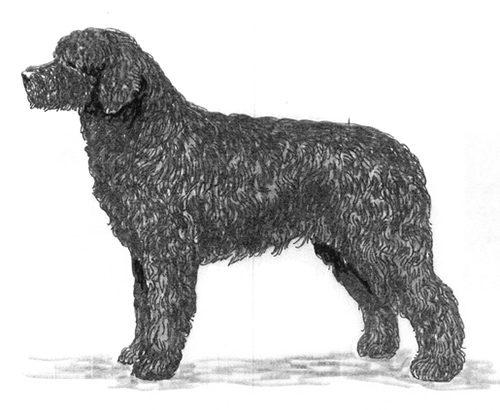Lagotto Romagnolo
Gun Dog Group
The goals and purposes of this breed standard include: to furnish guidelines for breeders who wish to maintain the quality of their breed and to improve it; to advance this breed to a state of similarity throughout the world; and to act as a guide for judges.
Breeders and judges have the responsibility to avoid any conditions or exaggerations that are detrimental to the health, welfare, essence and soundness of this breed, and must take the responsibility to see that these are not perpetuated.
Any departure from the following should be considered a fault, and the seriousness with which the fault should be regarded should be in exact proportion to its degree and its effect upon the health and welfare of the dog and on the dog’s ability to perform its traditional work.
History
The Lagotto Romagnolo is an ancient breed of water retrieving dog. As the great marshes were drained and turned into arable land, the breed changed into an excellent truffle hunting dog in the flat open country and hills of Romagna.
The Lagotto Romagnolo was recognized by the United Kennel Club in 2006.
General Appearance
A small to medium sized, well proportioned, powerfully built dog with a dense, curly coat that is wooly in texture.
Characteristics
A natural gift for searching and a strong nose has made this breed a very good dog for truffle searching. The Lagotto is tractable, keen and easy to train and very attached to his master. He is an excellent companion and watchdog.
Head
SKULL
Wide at the zygomatic arches, and as long as it is wide. The skull is longer than the muzzle, and it is slightly convex. The stop is not too pronounced.
MUZZLE
Fairly broad and slightly wedge shaped, with its depth being only slightly less than its length. The nasal bridge is straight. The lips are not too thick and rather tight, so that the lower profile of the muzzle is determined by the underjaw. The lips are covered with a long, bristly moustache, and the edges are brown in color.
TEETH
The Lagotto Romagnolo has a complete set of evenly spaced, white teeth meeting in a scissors, level or slightly undershot bite.
Disqualification: Overshot bite.
NOSE
The nose is large and slightly protruding, light to dark brown in color, depending on the color of the coat.
Disqualification: Nose pink, without pigmentation.
EYES
Fairly large and round, set well apart, with tight fitting lids. Color ranges from ochre through hazel to dark brown, depending on coat color. The eyelids are light to dark brown, and the expression is alert, keen and lively.
Disqualification: Wall eyes.
EARS
Medium sized and triangular in shape, with rounded tips, the ears are set just above the zygomatic arches. The ears hang when the dog is at rest and raise slightly at attention. They are covered with loose curls. There should be no short hair on the ears.
Neck
Strong, muscular and lean, slightly arched and free from dewlap, the neck is slightly shorter than the length of the head.
Forequarters
The shoulder blades are long and well laid back, forming an angle with the upper arm of approximately 110 degrees.
FORELEGS
Perfectly vertical with strong, compact oval bone, the forelegs are slightly longer than half the height at the withers. The pasterns are slightly finer and sloping.
Body
Compact, strong and square, with a topline that is straight from withers to croup. The chest is well developed in depth but fairly narrow. The back is straight and muscular, and the loin is short, broad and arched. The croup is long, wide and slightly sloping. There is only slight tuck up.
Hindquarters
The angulation of the hindquarters matches that of the forequarters.
HIND LEGS
The upper thigh is long and has clearly separated, visible muscles. The lower thigh is slightly longer than the upper thigh, and there is good angulation at the stifle. The hock joint is wide and lean and the rear pasterns are thin and perpendicular to the ground.
Feet
Slightly rounded and compact, with tight, arched toes and strong nails. The pads are well pigmented.
Tail
Set on following the line of the croup, and not too long, barely reaching the hocks. At rest it is carried hanging, when the dog is excited it is raised and can be carried over the back, but not curled.
Coat
Wooly in texture, forming tight curls that must be evenly distributed all over the body, except on the head where the curls are looser and form eyebrows, whiskers and a beard. There is a waterproof undercoat. If not clipped, the hair tends to become felted, so the coat should be clipped at least once a year.
Disqualification: Corded coat.
Color
Off white solid color, white with brown or orange patches, brown roan, solid brown of varying shades or solid orange. A brown face mask is acceptable.
Height and Weight
Ideal height at the withers for males is 18 inches. For females it is 17 inches. Weight ranges from 28 to 35 pounds for males, from 24 to 30 pounds for females.
Gait
Energetic and brisk.
Disqualifications
(A dog with a Disqualification must not be considered for placement in a conformation event, and must be reported to UKC.)
Unilateral or bilateral cryptorchid.
Viciousness or extreme shyness.
Albinism.
Nose pink, without pigmentation.
Overshot bite.
Wall eyes.
Corded coat.

Looking for a Dog?
Find a dog that will fit your family.
Note: The breeders on this list are not endorsed by UKC.
©Copyright 2006, United Kennel Club
